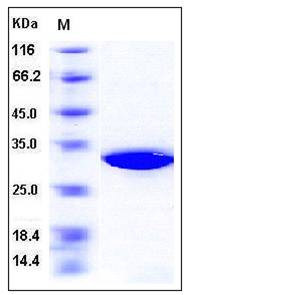Human SULT1A1 / STP1 Protein (His Tag)
HAST1/HAST2,P-PST,PST,ST1A1,ST1A3,STP,STP1,TSPST1
- 100ug (NPP4295) Please inquiry
| Catalog Number | P11658-H07E |
|---|---|
| Organism Species | Human |
| Host | E. coli |
| Synonyms | HAST1/HAST2,P-PST,PST,ST1A1,ST1A3,STP,STP1,TSPST1 |
| Molecular Weight | The recombinant human SULT1A1 consisting of 301 amino acids and has a calculated molecular mass of 35 kDa. It migrates as an approximately 32 kDa band in SDS-PAGE under reducing conditions. |
| predicted N | Met |
| SDS-PAGE |  |
| Purity | > 95 % as determined by SDS-PAGE |
| Protein Construction | A DNA sequence encoding the human SULT1A1 (P50225-1) (Glu 2-Leu 295) was fused with a polyhistidine tag at the N-terminus. |
| Bio-activity | |
| Research Area | Signaling |Signal Transduction |Metabolism |Pathways and Processes |Metabolic signaling pathways |Drug metabolism | |
| Formulation | Lyophilized from sterile 50mM Tris, 150mM NaCl, 10% glycerol, pH 8.0 1. Normally 5 % - 8 % trehalose and mannitol are added as protectants before lyophilization. Specific concentrations are included in the hardcopy of COA. |
| Background | Sulfate conjugation catalyzed by cytosolic sulfotransferase (SULT) enzymes. The SULTs are Phase II drug-metabolizing enzymes that catalyze the addition of a sulfuryl moiety to both endogenous compounds, including steroids and neurotransmitters, and certain xenobiotics, including N-hydroxy-2-acetylaminoflourine and phenolic compounds, like alpha-naphthol. SULTs may be involved in the individual genetic disposition, species differences, and organotropisms for toxicological effects of chemicals. Particularly SULT1A1 (Sulfotransferase family, cytosolic, 1A, phenol-preferring, member 1), a member of the sulfotransferase 1 subfamily, which is a major pathway for drug metabolism in humans. Humans have at least 10 functional SULT genes. There has been an explosion in information on sulfotransferase polymorphisms and their functional consequences. An Arg213His polymorphism in SULT1A1 has a strong influence on the level of enzyme protein and activity in platelets, which have been widely used for phenotyping. Statistically significant associations were observed between the SULT1A1 genotype (Arg213His) and age, obesity and certain neoplasias (mammary, pulmonary, esophageal and urothelial cancer). Furthermore, the polymorphism of the SULT1A1 may be closely associated with breast cancer. |
| Reference |
